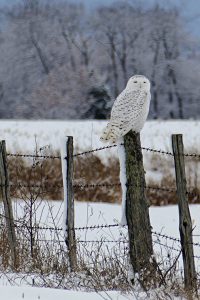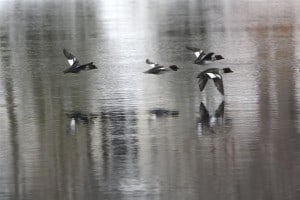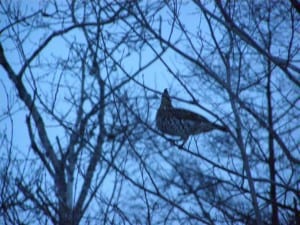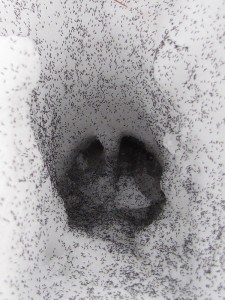Looking back at extreme fall temperatures and ahead to what nature has in store
As is now the pattern with a changing climate, fall weather this year was marked by extreme temperatures. For many days in November, minimum temperatures were equal to or below historical lows. In Peterborough, the temperature fell to a bone-chilling -22.9 C on November 13, shattering the previous record low of -17.8 C, set back in 1871. Overall, November was a whopping 3.4 C colder than normal. The same thing occurred last November when temperatures averaged 2.6 C cooler than usual.
Some people might take comfort in these episodes of cold weather and believe that global warming is greatly exaggerated. Unfortunately, there is much about climate change that is complicated and far from intuitive. The record cold in November may in fact be linked to a disruption of the Polar Vortex, the whirling mass of cold air, which usually stays close to the poles. Research by Dr. Jennifer Francis, an atmospheric scientist at Wood’s Hole Research Centre, suggests a warming Arctic is contributing to a more extreme, wavy jet stream, which allows the vortex to spill southward. According to the Weather Network, this pattern of below-normal temperatures will likely continue all winter.
As a reminder of what to watch for in nature in the coming months, here are some highlights.
DECEMBER
· Keep an eye out for snowy owls. Several birds have already been seen in fields along Post Road, east of Lindsay. They often turn up at the Peterborough Airport, as well. These owls typically perch on knolls, fences, hay bales, signs, buildings or right on the ground. For the latest sightings, visit my Sightings page at drewmonkman.com.
· This year’s huge wild grape crop means that large numbers of robins will likely overwinter in the Kawarthas. Grapes are one of their favourite foods.
· Watch for wild turkeys. Their large, dark bodies are easy to spot in winter as flocks feed in fields.
· In the ongoing debate on real versus artificial Christmas trees, it still seems that real trees are the greenest choice. Artificial trees are made from non-recyclable plastic and are produced and shipped from overseas, typically China. Real trees have a much smaller transportation carbon footprint, are 100% biodegradable, smell great, and can be made into mulch for city parks. Christmas tree farms are also carbon sinks, soaking up carbon dioxide in the atmosphere as new trees are planted each year.
· Ducks lingering on local lakes and rivers until freeze-up include common goldeneye, buffleheads and both common and hooded mergansers. Some will remain on open water such as the Otonabee River all winter.
· Christmas Bird Count season is once again upon us. The 68th Peterborough count will be held on Sunday, December 15, while the Petroglyphs count takes place on Saturday, January 4. Participants record all of the birds they see and hear within a 24 kilometer circle. The Peterborough count includes the city itself and surrounding area, while the Petroglyph count covers a territory stretching from the north shore of Stoney Lake to the Aspley-Jack Lake area. Anyone with an interest in birds is invited to take part . At the end of the day, all participants are invited to a count wrap-up and compilation of the results. To register, contact Martin Parker (705-745-4750 or by email at mparker19@cogeco.ca) for the Peterborough count and Colin Jones (705-750-7998 or by email at colin.jones@ontario.ca) for the Petroglyph count.
· Saturday, December 21, marks the winter solstice and the first day of winter. The sun rises and sets at its southernmost points on the eastern and western horizons and remains low in the sky all day. Daylight in December averages less than nine hours – about half as much as in June.
· Watch for evening grosbeaks at your sunflower seed feeder this winter, especially if you live north of Peterborough. It is unlikely, however, that other northern finches like redpolls and siskins will turn up this year.
JANUARY
· If you’re up late on January 10, take a glance outside at the full moon. The early-winter moon rides higher in the sky than at any other season and passes nearly overhead at midnight. Moonlit winter nights shine with an unforgettable brilliance. The Ojibway called the moon of January the Spirit Moon.
· In our woodlots, mixed flocks of foraging chickadees, nuthatches and woodpeckers bring life to the seemingly empty winter landscape. These birds are very receptive to pishing and can usually be coaxed to come in quite close.
· The Winter Six and their assortment of bright stars light up January evenings. Look for the constellations Orion, Taurus, Gemini, Auriga, Canis Major and Canis Minor.
· Watch for ruffed grouse at dawn and dusk along tree-lined country roads. They often appear in silhouette as they feed on the buds of trees such as the trembling aspen.
· If you’re driving through open farm country, keep an eye open for huge, swirling flocks of snow buntings. It is not uncommon to see hundreds of these white birds in a single flock.
FEBRUARY
· We begin the month with about 9 ¾ hours of daylight and end with 11, a gain of about 75 minutes. The lengthening days are most notable in the afternoon.
· Being social animals, northern flying squirrels sometimes join up in single-sex groups for warmth during the winter. They will often huddle together in a tree cavity. Flying squirrels sometimes turn up at bird feeders, as well.
· Bird song returns in February as pair bonds are established or renewed. Black-capped chickadees, northern cardinals, house finches, and white-breasted nuthatches are several of the birds that usually start singing this month.
· Gray squirrels mate in January or February and can often be seen streaming by in treetop chases as a group of males pursues a half-terrorized female.
· The Great Backyard Bird Count takes place Friday, February 14, through Monday, February 17. Anyone can participate. You can count for as little as 15 minutes on a single day, or for as long as you like each day of the event. This is a great event for kids. Go to gbbc.birdcount.org for details.
· With mating season starting, red foxes become more active. It’s quite common to spot their straight-lined trails, even in suburban backyards. Occasionally we see foxes hunting for mice and voles at dusk or dawn.
· If you are walking through a snow-covered field or along a roadside, watch for a ball-like gall growing on the stems of goldenrods. It contains the tiny, white larva of the goldenrod gall fly and is a favourite food of downy woodpeckers and chickadees.
MARCH
· Bufflehead, goldeneye, and common merganser numbers increase on the Otonabee River, and the first hooded mergansers since December usually return.
· On mild afternoons along woodland trails, watch for snow fleas on the surface of the snow. Only about a millimetre in length, thousands can often be seen covering the snow like spilt pepper.
· The buds of lilac, red-berried elder, red maple, and silver maple swell this month and become much more noticeable than earlier in the winter.
· The Presqu’ile Waterfowl Weekend usually takes place in mid-March and is well worth the drive to Brighton. You will observe one of Ontario’s great natural spectacles, namely the return of thousands of migrating waterfowl to their staging areas along the lower Great Lakes. Contact David Bree at 613-475-4324, ext 225 or david.bree@ontario.ca for more information
· Sandhill cranes return to the Kawarthas in late March and can sometimes be seen performing their courtship dance. It includes head bobbing, bowing and leaping into the air. Douro Third Line is sometimes a good place to see these birds.
Climate Crisis Update
A plethora of major climate reports have come out in recent weeks to help set the stage for the COP 25 climate talks, which continue in Madrid. Here are some of the key findings: 1. The United Nations Emissions Gap report for 2019 (unenvironment.org/resources/emissions-gap-report-2019https://www.unenvironment.org/resources/emissions-gap-report-2019) says that despite scientific warnings and political commitments, greenhouse gas emissions are continuing to rise at about 1.5 percent per year. There is no sign of emissions peaking in the next few years. 2. According to the World Meteorological Organization (public.wmo.int/en/media), levels of heat-trapping greenhouse gases in the atmosphere reached another new record high in 2018 at 407.8 parts per million. Concentrations of methane and nitrous oxide also surged. 3. Another United Nations study (productiongap.org/2019report/) found that governments are planning to produce about 50% more fossil fuels by 2030 than would be consistent with limiting warming to 2°C and 120% more than would keep warming to 1.5 C. This is putting the world on track to warm by a disastrous 3 degrees C by 2100 and makes meeting the Paris targets virtually impossible. Canada’s oil and natural gas production is projected to increase 60% and 34%, respectively, between 2017 and 2040. The report says that “once built, new infrastructure (e.g., pipelines) is difficult to turn away from.” 4. A frightening commentary in the journal Nature (nature.com/articles/d41586-019-03595-0) reports growing evidence that irreversible “tipping points” in which one shift amplifies another could be triggered within a few decades. Some models suggest that the Greenland ice sheet could be doomed to disappear if the world warms by just 1.5 C. The Amundsen Sea embayment of West Antarctica might have already passed a tipping point, which could lead to the rest of the West Antarctic ice sheet toppling like dominoes. On a positive note, an article in the Independent (independent.co.uk/news/education/education-news) says that headteachers and psychotherapists in the U.K. report that involvement in climate change activism is reducing symptoms of “eco-anxiety” among young people and boosting their wellbeing.



